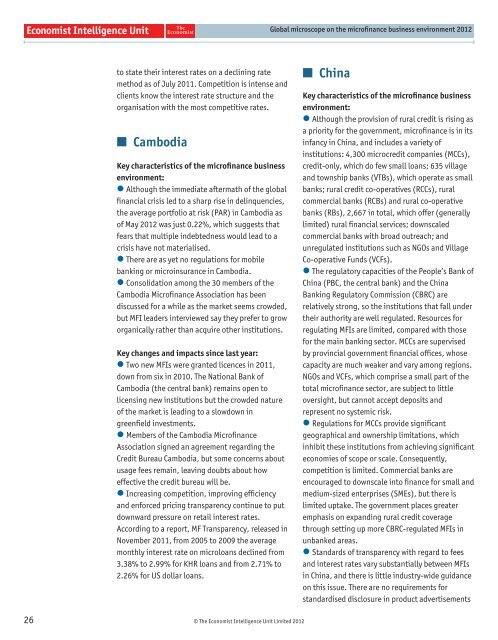Global microscope on the microfinance business environment 2012
Global microscope on the microfinance business environment 2012
Global microscope on the microfinance business environment 2012
Create successful ePaper yourself
Turn your PDF publications into a flip-book with our unique Google optimized e-Paper software.
26<br />
to state <strong>the</strong>ir interest rates <strong>on</strong> a declining rate<br />
method as of July 2011. Competiti<strong>on</strong> is intense and<br />
clients know <strong>the</strong> interest rate structure and <strong>the</strong><br />
organisati<strong>on</strong> with <strong>the</strong> most competitive rates.<br />
■ Cambodia<br />
Key characteristics of <strong>the</strong> microfi nance <strong>business</strong><br />
envir<strong>on</strong>ment:<br />
l Although <strong>the</strong> immediate aftermath of <strong>the</strong> global<br />
fi nancial crisis led to a sharp rise in delinquencies,<br />
<strong>the</strong> average portfolio at risk (PAR) in Cambodia as<br />
of May <strong>2012</strong> was just 0.22%, which suggests that<br />
fears that multiple indebtedness would lead to a<br />
crisis have not materialised.<br />
l There are as yet no regulati<strong>on</strong>s for mobile<br />
banking or microinsurance in Cambodia.<br />
l C<strong>on</strong>solidati<strong>on</strong> am<strong>on</strong>g <strong>the</strong> 30 members of <strong>the</strong><br />
Cambodia Microfi nance Associati<strong>on</strong> has been<br />
discussed for a while as <strong>the</strong> market seems crowded,<br />
but MFI leaders interviewed say <strong>the</strong>y prefer to grow<br />
organically ra<strong>the</strong>r than acquire o<strong>the</strong>r instituti<strong>on</strong>s.<br />
Key changes and impacts since last year:<br />
l Two new MFIs were granted licences in 2011,<br />
down from six in 2010. The Nati<strong>on</strong>al Bank of<br />
Cambodia (<strong>the</strong> central bank) remains open to<br />
licensing new instituti<strong>on</strong>s but <strong>the</strong> crowded nature<br />
of <strong>the</strong> market is leading to a slowdown in<br />
greenfi eld investments.<br />
l Members of <strong>the</strong> Cambodia Microfi nance<br />
Associati<strong>on</strong> signed an agreement regarding <strong>the</strong><br />
Credit Bureau Cambodia, but some c<strong>on</strong>cerns about<br />
usage fees remain, leaving doubts about how<br />
effective <strong>the</strong> credit bureau will be.<br />
l Increasing competiti<strong>on</strong>, improving effi ciency<br />
and enforced pricing transparency c<strong>on</strong>tinue to put<br />
downward pressure <strong>on</strong> retail interest rates.<br />
According to a report, MF Transparency, released in<br />
November 2011, from 2005 to 2009 <strong>the</strong> average<br />
m<strong>on</strong>thly interest rate <strong>on</strong> microloans declined from<br />
3.38% to 2.99% for KHR loans and from 2.71% to<br />
2.26% for US dollar loans.<br />
© The Ec<strong>on</strong>omist Intelligence Unit Limited <strong>2012</strong><br />
<str<strong>on</strong>g>Global</str<strong>on</strong>g> <str<strong>on</strong>g>microscope</str<strong>on</strong>g> <strong>on</strong> <strong>the</strong> microfi nance <strong>business</strong> envir<strong>on</strong>ment <strong>2012</strong><br />
■ China<br />
Key characteristics of <strong>the</strong> microfi nance <strong>business</strong><br />
envir<strong>on</strong>ment:<br />
l Although <strong>the</strong> provisi<strong>on</strong> of rural credit is rising as<br />
a priority for <strong>the</strong> government, microfi nance is in its<br />
infancy in China, and includes a variety of<br />
instituti<strong>on</strong>s: 4,300 microcredit companies (MCCs),<br />
credit-<strong>on</strong>ly, which do few small loans; 635 village<br />
and township banks (VTBs), which operate as small<br />
banks; rural credit co-operatives (RCCs), rural<br />
commercial banks (RCBs) and rural co-operative<br />
banks (RBs), 2,667 in total, which offer (generally<br />
limited) rural fi nancial services; downscaled<br />
commercial banks with broad outreach; and<br />
unregulated instituti<strong>on</strong>s such as NGOs and Village<br />
Co-operative Funds (VCFs).<br />
l The regulatory capacities of <strong>the</strong> People’s Bank of<br />
China (PBC, <strong>the</strong> central bank) and <strong>the</strong> China<br />
Banking Regulatory Commissi<strong>on</strong> (CBRC) are<br />
relatively str<strong>on</strong>g, so <strong>the</strong> instituti<strong>on</strong>s that fall under<br />
<strong>the</strong>ir authority are well regulated. Resources for<br />
regulating MFIs are limited, compared with those<br />
for <strong>the</strong> main banking sector. MCCs are supervised<br />
by provincial government fi nancial offi ces, whose<br />
capacity are much weaker and vary am<strong>on</strong>g regi<strong>on</strong>s.<br />
NGOs and VCFs, which comprise a small part of <strong>the</strong><br />
total microfi nance sector, are subject to little<br />
oversight, but cannot accept deposits and<br />
represent no systemic risk.<br />
l Regulati<strong>on</strong>s for MCCs provide signifi cant<br />
geographical and ownership limitati<strong>on</strong>s, which<br />
inhibit <strong>the</strong>se instituti<strong>on</strong>s from achieving signifi cant<br />
ec<strong>on</strong>omies of scope or scale. C<strong>on</strong>sequently,<br />
competiti<strong>on</strong> is limited. Commercial banks are<br />
encouraged to downscale into fi nance for small and<br />
medium-sized enterprises (SMEs), but <strong>the</strong>re is<br />
limited uptake. The government places greater<br />
emphasis <strong>on</strong> expanding rural credit coverage<br />
through setting up more CBRC-regulated MFIs in<br />
unbanked areas.<br />
l Standards of transparency with regard to fees<br />
and interest rates vary substantially between MFIs<br />
in China, and <strong>the</strong>re is little industry-wide guidance<br />
<strong>on</strong> this issue. There are no requirements for<br />
standardised disclosure in product advertisements















![Joint Report on Social Protection and Social Inclusion [2005]](https://img.yumpu.com/19580638/1/190x132/joint-report-on-social-protection-and-social-inclusion-2005.jpg?quality=85)
